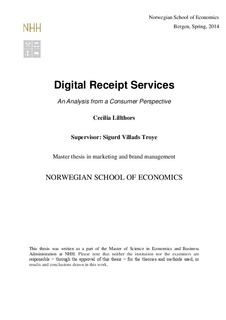Digital receipt services : an analysis from a consumer perspective
Abstract
The objective of this research is: to understand consumers’ use of receipt today and how they perceive digital receipt services (DRS).
The purpose is to explore the underlying barriers for adoption, acceptance and use of this type of service among consumers.
To reach the objective stated above, twenty-six interviews were conducted, asking about consumers’ experience with the current solution with paper receipts, their experience with technology and how they perceive DRS.
Questions from the interviews are deduced from theories about technology adoption mainly from Technology Acceptance Model and Diffusion of Innovations, with additional concepts found in previous research.
Based on the responses in the interviews four different groups were identified; The Technical Non-Controller (TNC), The Technical Controller (TC), The Non-Technical Controller (NTC) and The Non-Technical Non-Controller (NTNC).
The results show that there are relatively few people who save all their paper receipts today. In this study, there were only five participants that saved all their receipts. The rest of the participants only kept receipts that they perceived as “important” or “expensive”.
All participants used computer and mobile phone on a regular basis. However, the interest for technology and technological innovations differed among them.
The result also showed that the attitude towards DRS in general is positive. Twenty-four of the participants perceived DRS as a potential future distribution chain for receipts. Still, only five of those interviewed said they were willing to try the service as the infrastructure is today.
Based on the interviews, the main barriers for adoption seem to be the perceived usefulness, ease of use, subjective norm and security regarding DRS. Past experience and perceived behavioral control were also found to have a great influence.
